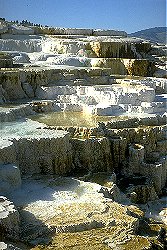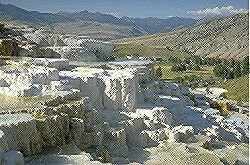Mammoth Hot Springs
Useful Information
| Location: | Yellowstone National Park, USA. Northern part of the park, south of Gardiner, MT, at the park headquarter. I90, exit Livingston, Hwy 89 south. |
| Open: |
North Entrance open all year daily 0-24. No restrictions for access to the Hot Spring, though daylight is advisable. [2005] |
| Fee: |
MAY to OCT: Car USD 25, Motorcycle USD 20, Individual USD 12. NOV to APR: Car USD 20, Motorcycle USD 15, Individual USD 10. The tickets are good for 7 days in both parks. [2005] |
| Classification: |
 Sinter Terraces Sinter Terraces
|
| Light: | n/a |
| Dimension: | |
| Guided tours: | Terrace Geology Talk |
| Photography: | |
| Accessibility: | |
| Bibliography: | |
| Address: | Yellowstone National Park, P.O. Box 168, Yellowstone National Park, WY 82190-0168, Tel: +1-307-344-7381, Mammoth Hot Springs Visitor Center +11-307-344-2263 |
| As far as we know this information was accurate when it was published (see years in brackets), but may have changed since then. Please check rates and details directly with the companies in question if you need more recent info. |
|
History
| 01-MAR-1872 | the world’s first national park established. |
| 1976 | designated a Biosphere Reserve. |
| 06-SEP-1978 | designated a World Heritage Site. |
Description


Mammoth Hot Springs is one of very few
 rimstone pools
above ground.
And they are probably the most beautiful ones.
rimstone pools
above ground.
And they are probably the most beautiful ones.
The rimstone pools are made of limestone (travertine), like rimstone pools in caves. This is rather unusual, as they are formed by thermal (hot) springs which normally deposit silica (sinter or geyserite). But the temperature of the water ist not high enough to form geyserite, it is only 75 °C warm.
The carbon dioxide in the water vanishes into the air very fast, because of the high water temperature, the limestone is deposited and the pools grow very quickly, much quicker than underground. A second reason for the fast growth, beneath the temperature, may be the existence of algae, that feed on the carbon dioxide in the water and cause the water to accumulate the calcite. They also cause the different colours of the rims, which vanish when the rocks fall dry. When the algae die, they dry, are blown away, and the pure white limestone remains.
The pools are located in the northern part of the National Park, close to the park headquarter. The springs were once called McGuirk’s Medicinal Springs. The water from the spring forms a hot tributary of nearby Gardiner River called Hot River. Here, where the two waters meet, is one of the few places in the park where swimming in the thermal waters is allowed.
The Mammoth Hot Springs Terraces are divided into two parts, the Lower Terraces and the Upper Terraces. The Upper Terraces are less spectacular, and there is no trail. A one-way drive through the terraces offers views of these fascinating formations, and there are various possibilities to stop. At the first stop is an overlook and a trail to Canary Spring and one down to the Lower Terraces starts.
The Lower Terraces are the main sight here, with a net of walking trails through the most impressive part, which allows a close and unhurried look. Minerva Spring is one of the numerous springs, located right in the middle of this group. It is a favorite place, not only because of the wide range of bright colors, but also for its ornate travertine formations forming stalactites and shawl.
Most of the springs and terraces are west of the road, but there is Opal Terrace on the east side towards Historic Fort Yellowstone. Opal Spring flows from the base of Capitol Hill. This spring became active in 1926 and started to deposit 35 cm of travertine per year. In 1947 a tennis court was removed to allow natural expansion of the terrace. It is now close to a historic home designed by Robert Reamer in 1908. To protect the house, sandbags and an earthen wall were used.
Records about the springs were first kept in the 1890’s. The location of springs and the rate of flow changes daily, but the overall volume of water discharge by all springs fluctuates little. Nevertheless, the springs have gone through a series of active and inactive periods. For example Minerva Spring was completely dry for several years at the beginning of the 20th century. In the middle of the 20th century it was very active and extremely beautiful. During such periods of extremely high activity the trails have been buried under new travertine deposits. During the 1970’s activity decreased, but increased at some other springs in the lower terrace area. The cyanobacteria mats of that springs now rival those at Minerva Spring.
- See also
 Search DuckDuckGo for "Mammoth Hot Springs"
Search DuckDuckGo for "Mammoth Hot Springs" Google Earth Placemark
Google Earth Placemark Yellowstone National Park (National Park Service), official website.
Yellowstone National Park (National Park Service), official website. Mammoth Hot Springs Online Tour, official website. A detailed description of the pools.
Mammoth Hot Springs Online Tour, official website. A detailed description of the pools. The Total Yellowstone Page
The Total Yellowstone Page Mammoth Hot Springs at VolcanoWorld
Mammoth Hot Springs at VolcanoWorld Rick Reed
Rick Reed 3D Image
3D Image
 Index
Index Topics
Topics Hierarchical
Hierarchical Countries
Countries Maps
Maps